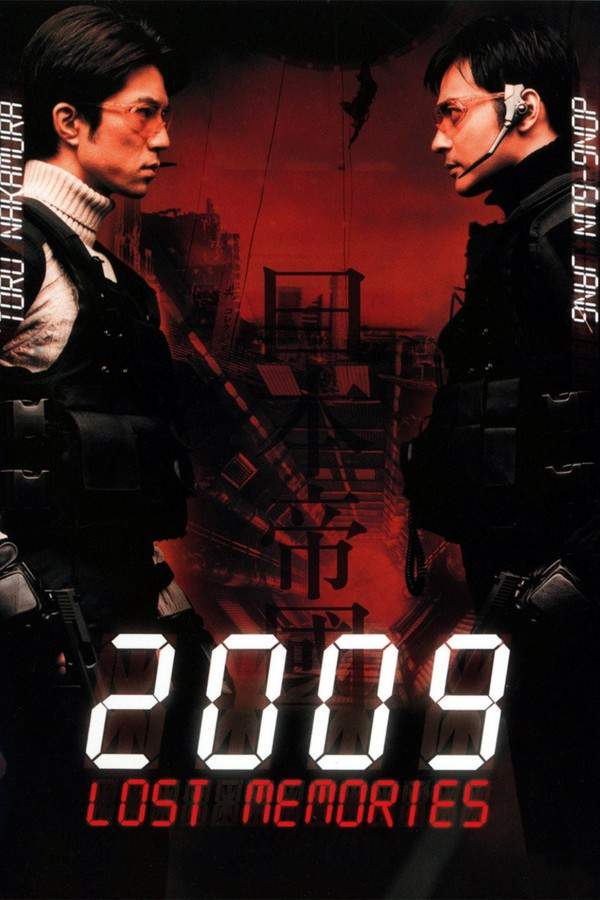
A catastrophic event looms, threatening to erase Korea's future and its history. Two rival agents, pulled from different points in time, are forced to work together to avert the disaster and protect their homeland. As they confront the dangers of manipulating time, they must question their loyalties and face the unforeseen consequences of altering the course of destiny in this action-packed thriller.
Does 2009: Lost Memories have end credit scenes?
No!
2009: Lost Memories does not have end credit scenes. You can leave when the credits roll.
Meet the Full Cast and Actors of 2009: Lost Memories
Explore the complete cast of 2009: Lost Memories, including both lead and supporting actors. Learn who plays each character, discover their past roles and achievements, and find out what makes this ensemble cast stand out in the world of film and television.
No actors found
External Links and Streaming Options
Discover where to watch 2009: Lost Memories online, including streaming platforms, rental options, and official sources. Compare reviews, ratings, and in-depth movie information across sites like Wikipedia, Rotten Tomatoes or Metacritic.
Ratings and Reviews for 2009: Lost Memories
See how 2009: Lost Memories is rated across major platforms like IMDb, Metacritic, and TMDb. Compare audience scores and critic reviews to understand where 2009: Lost Memories stands among top-rated movies in its genre.

40
Metascore
6.8
User Score


43%
TOMATOMETER

56%
User Score
Take the Ultimate 2009: Lost Memories Movie Quiz
Challenge your knowledge of 2009: Lost Memories with this fun and interactive movie quiz. Test yourself on key plot points, iconic characters, hidden details, and memorable moments to see how well you really know the film.
2009: Lost Memories Quiz: Test your knowledge of the intricate plot and characters in the film '2009: Lost Memories'.
What operation are agents Masayuki Sakamoto and Shojiro Saigo involved in?
A high-stakes investigation of a terrorist group
A quest for ancient artifacts
A diplomatic mission
A rescue operation
Show hint
Full Plot Summary and Ending Explained for 2009: Lost Memories
Read the complete plot summary of 2009: Lost Memories, including all major events, twists, and the full ending explained in detail. Explore key characters, themes, hidden meanings, and everything you need to understand the story from beginning to end.
As Imperial Japan’s stronghold over the Korean Peninsula tightened in 2009, two distinguished agents from the Japanese Bureau of Investigation (JBI), Masayuki Sakamoto and Shojiro Saigo, found themselves embroiled in a high-stakes operation that would test their resolve and skills. The situation escalated dramatically when a group of terrorists, known as the Hureisenjin, executed a brazen hostage crisis at the Keijo museum. Though the motivations behind this audacious stunt were initially unclear, Sakamoto’s diligent investigation soon revealed a mysterious link to a crescent-shaped artifact known as the “Lunar Soul”, which had been captured from one of the fallen terrorists. As the JBI continued to peel back the layers of the Hureisenjin’s plans, it became glaringly evident that their primary objective was the historically significant Inoue Foundation—an organization rooted in artifacts amassed during the tenure of Korea’s second Governor-General.
As Sakamoto and Saigo delved deeper into the intricate world of artifact collection, they grappled with the Hureisenjin’s seemingly unreasonable obsession with these historical treasures. However, just when they thought they could sort through the clues, the terrorists struck again, brutally ambushing a convoy carrying artifacts belonging to the Inoue Foundation and making off with the prized Lunar Soul. The ensuing confrontation forced Sakamoto to face off against the enigmatic leader of the Hureisenjin, Oh Hye-rin, in an intense standoff that would leave emotional scars on both sides.
Sakamoto’s probing inquiries into the Inoue Foundation’s dealings ignited a firestorm of doubt and distrust among his superiors. Adding to his challenges was the troubling memory of his father’s execution as a traitor for allegedly assisting an earlier attack by the Hureisenjin on a cargo ship bound for Vladivostok in 1985. This shadowy past further tarnished Sakamoto’s reputation, leading to his ousting from the case. Undaunted, he set out on an independent mission to Harbin, hoping to piece together the secrets surrounding the Lunar Soul.
Just as Sakamoto began to gain ground, he faced a devastating setback when Takahashi, his trusted mentor, was mercilessly murdered in his own home. Following this tragedy, Sakamoto found himself arrested and charged for the crime. In a shocking twist, Saigo, once his ally, pledged to become his adversary the next time they would meet. Consequently, with the JBI closing in, Sakamoto was forced underground, relying solely on his resourcefulness and intuition to evade capture.
While hiding, Sakamoto found himself injured within the secretive lair of the Hureisenjin. Here, a clandestine discussion took place between Saigo and a high-ranking figure from the Inoue Foundation. What they uncovered was astonishing—their existence was merely a warped reflection of a parallel universe. This monumental realization arose from archaeological efforts in 2009, during which Chinese, Korean, and Japanese scholars stumbled upon a colossal stone temple possessing the extraordinary ability to manipulate time. The Japanese ultranationalist group Uyoku dantai seized upon this ancient discovery, using its power to send their leader Inoue back exactly 100 years to prevent the assassination of Resident-General Itō Hirobumi on October 26, 1909.
This temporal meddling had far-reaching implications. With Itō’s survival and Inoue’s foreknowledge, Japan sidestepped defeat alongside its Axis counterparts in World War II, eventually forging an unexpected alliance with the United States against Nazi Germany. Consequently, the war came to a close in 1945, marked by the atomic bombing of Berlin instead of Hiroshima and Nagasaki. As a victorious nation, Japan ascended to military and economic supremacy, securing a permanent seat on the U.N. Security Council while maintaining its colonial empire. Inoue’s descendants constructed the Inoue Foundation, carefully guarding the knowledge of this altered timeline from prying eyes, with only a select few in Japan’s government privy to the secret.
Amidst this complex narrative, a Korean researcher motivated by an unwavering resolve to correct the past had relentlessly pursued Inoue, aiming to thwart his actions. This tenacious individual founded the Hureisenjin, passing down the story of this distorted timeline in hopes of restoring the original chronology.
As Sakamoto’s awareness of this altered history expanded, he surprisingly allied with the Hureisenjin, who had secured control of the coveted temple stone and were preparing for an all-out assault. However, their aspirations were brutally curtailed when the JBI raided their hideout, leaving devastation in their wake. Amid the chaos, Sakamoto and his ally Hye-rin managed to escape with the Lunar Soul, seeking refuge on a tanker ship where the Inoue Foundation held its precious artifacts. There, they discovered the temple stone and placed the Lunar Soul within it, inadvertently activating its powers as they were ensnared in a gunfight with the JBI. Tragedy struck as Hye-rin succumbed to her injuries, leaving Sakamoto as the sole guardian of the timeline’s fate. With a heavy heart, he journeyed back in time to Harbin in 1909, pursued by Saigo, who was determined to prevent Sakamoto from altering reality. Saigo was motivated by the grave knowledge that restoring the original timeline would endanger his wife’s family amidst the atomic bombing of Hiroshima.
As Sakamoto raced to stop Inoue’s lethal intentions, he wounded Saigo before reaching the railway station. Just as Sakamoto prepared for action, Saigo reemerged, intent on frustrating his plans. In the end, Sakamoto overcame Inoue and subdued Saigo, allowing An to fulfill his destiny by assassinating Itō. Later, Sakamoto was seen covertly planting explosives to obliterate the temple stone when Hye-rin unexpectedly appeared beside him. The evolving truth revealed that this version of Hye-rin was indeed a Korean researcher from the original timeline, having followed Inoue’s temporal journey, despite never having met Sakamoto in her own reality.
Returning to 2009, the restored timeline was starkly apparent as a young boy, who previously shared a heartfelt connection with Sakamoto in the alternate reality, stood before a gallery honoring Korean heroes and leaders at Independence Hall, including a cherished portrait of Sakamoto and Hye-rin, happily together.
Uncover the Details: Timeline, Characters, Themes, and Beyond!

Coming soon on iOS and Android
The Plot Explained Mobile App
From blockbusters to hidden gems — dive into movie stories anytime, anywhere. Save your favorites, discover plots faster, and never miss a twist again.
Sign up to be the first to know when we launch. Your email stays private — always.
Discover Film Music Concerts Near You – Live Orchestras Performing Iconic Movie Soundtracks
Immerse yourself in the magic of cinema with live orchestral performances of your favorite film scores. From sweeping Hollywood blockbusters and animated classics to epic fantasy soundtracks, our curated listings connect you to upcoming film music events worldwide.
Explore concert film screenings paired with full orchestra concerts, read detailed event information, and secure your tickets for unforgettable evenings celebrating legendary composers like John Williams, Hans Zimmer, and more.



Unlock the World of Movies with Our Comprehensive Wiki
Dive into our Movie Wiki for in-depth film encyclopedia entries, including cast biographies, production trivia, plot synopses, behind-the-scenes facts, and thematic analyses. Whether you’re researching iconic directors, exploring genre histories, or discovering hidden easter eggs, our expertly curated movie database has everything you need to fuel your cinematic passion.

Quick Links: Summary, Cast, Ratings, More

What's After the Movie?
Not sure whether to stay after the credits? Find out!
Explore Our Movie Platform
New Movie Releases (2025)
Famous Movie Actors
Top Film Production Studios
Movie Plot Summaries & Endings
Major Movie Awards & Winners
Best Concert Films & Music Documentaries
Movie Collections and Curated Lists
© 2025 What's After the Movie. All rights reserved.










